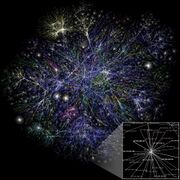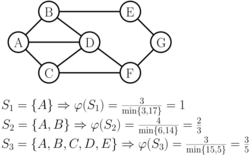Conductance (graph)
| Network science | ||||
|---|---|---|---|---|
| Network types | ||||
| Graphs | ||||
|
||||
| Models | ||||
|
||||
| ||||
In graph theory the conductance of a graph G = (V, E) measures how "well-knit" the graph is: it controls how fast a random walk on G converges to its stationary distribution. The conductance of a graph is often called the Cheeger constant of a graph as the analog of its counterpart in spectral geometry.[citation needed] Since electrical networks are intimately related to random walks with a long history in the usage of the term "conductance", this alternative name helps avoid possible confusion.
The conductance of a cut [math]\displaystyle{ (S, \bar S) }[/math] in a graph is defined as:
- [math]\displaystyle{ \varphi(S) = \frac{\sum_{i \in S, j \in \bar S}a_{ij}}{\min(a(S),a(\bar S))} }[/math],
where the aij are the entries of the adjacency matrix for G, so that
- [math]\displaystyle{ a(S) = \sum_{i \in S} \sum_{j \in V} a_{ij} }[/math]
is the total number (or weight) of the edges incident with S. a(S) is also called a volume of the set [math]\displaystyle{ S \subseteq V }[/math].
The conductance of the whole graph is the minimum conductance over all the possible cuts:
- [math]\displaystyle{ \phi(G) = \min_{S \subseteq V}\varphi(S). }[/math]
Equivalently, conductance of a graph is defined as follows:
- [math]\displaystyle{ \phi(G) := \min_{S \subseteq V; 0\leq a(S)\leq a(V)/2}\frac{\sum_{i \in S, j \in \bar S}a_{ij}}{a(S)}.\, }[/math]
For a d-regular graph, the conductance is equal to the isoperimetric number divided by d.
Generalizations and applications
In practical applications, one often considers the conductance only over a cut. A common generalization of conductance is to handle the case of weights assigned to the edges: then the weights are added; if the weight is in the form of a resistance, then the reciprocal weights are added.
The notion of conductance underpins the study of percolation in physics and other applied areas; thus, for example, the permeability of petroleum through porous rock can be modeled in terms of the conductance of a graph, with weights given by pore sizes.
Conductance also helps measure the quality of a Spectral clustering. The maximum among the conductance of clusters provides a bound which can be used, along with inter-cluster edge weight, to define a measure on the quality of clustering. Intuitively, the conductance of a cluster (which can be seen as a set of vertices in a graph) should be low. Apart from this, the conductance of the subgraph induced by a cluster (called "internal conductance") can be used as well.
Markov chains
For an ergodic reversible Markov chain with an underlying graph G, the conductance is a way to measure how hard it is to leave a small set of nodes. Formally, the conductance of a graph is defined as the minimum over all sets [math]\displaystyle{ S }[/math] of the capacity of [math]\displaystyle{ S }[/math] divided by the ergodic flow out of [math]\displaystyle{ S }[/math]. Alistair Sinclair showed that conductance is closely tied to mixing time in ergodic reversible Markov chains. We can also view conductance in a more probabilistic way, as the probability of leaving a set of nodes given that we started in that set to begin with. This may also be written as
- [math]\displaystyle{ \Phi = \min_{S \subseteq V, 0 \lt \pi(S) \leq \frac{1}{2}}\Phi_S = \min_{S \subseteq V, 0 \lt \pi(S) \leq \frac{1}{2}}\frac{\sum_{x \in S, y \in \bar S} \pi(x) P(x,y)}{\pi(S)}, }[/math]
where [math]\displaystyle{ \pi }[/math] is the stationary distribution of the chain. In some literature, this quantity is also called the bottleneck ratio of G.
Conductance is related to Markov chain mixing time in the reversible setting. Precisely, for any irreducible, reversible Markov Chain with self loop probabilities [math]\displaystyle{ P(y,y) \geq 1/2 }[/math] for all states [math]\displaystyle{ y }[/math] and an initial state [math]\displaystyle{ x \in \Omega }[/math],
- [math]\displaystyle{ \frac{1}{4 \Phi} \leq \tau_x(\delta) \leq \frac{2}{\Phi^2} \big( \ln \pi(x)^{-1} + \ln \delta^{-1} \big) }[/math].
See also
- Resistance distance
- Percolation theory
- Krackhardt E/I Ratio
References
- Béla Bollobás (1998). Modern graph theory. GTM. 184. Springer-Verlag. p. 321. ISBN 0-387-98488-7.
- Kannan, R.; Vempala, S.; Vetta, A. (May 2004). "On clusterings: Good, bad and spectral". J. ACM 51 (3): 497–515. doi:10.1145/990308.990313. http://www.cc.gatech.edu/~vempala/papers/jacm-spectral.pdf.
- Fan Chung (1997). Spectral Graph Theory. CBMS Lecture Notes. 92. AMS Publications. p. 212. ISBN 0-8218-0315-8.
- A. Sinclair. Algorithms for Random Generation and Counting: A Markov Chain Approach. Birkhauser, Boston-Basel-Berlin, 1993.
- D. Levin, Y. Peres, E. L. Wilmer: Markov Chains and Mixing Times
 |



